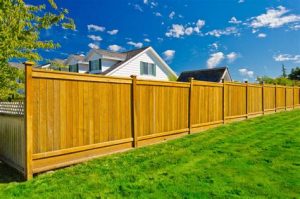Learn how to assess your property, choose materials, understand regulations, prepare your ground, and follow a step-by-step installation process for successful projects.Are you considering installing a fence around your property? Whether it’s for enhancing privacy, adding security, or creating a defined boundary, a well-constructed fence can be a valuable addition to any home. However, the thought of a DIY fencing project can seem daunting at first. Fear not! In this step-by-step guide, we will walk you through the essential considerations for installing your own fence, from assessing your property to choosing the right materials and understanding local regulations. We’ll also provide detailed instructions on preparing the ground and carrying out the installation. With the right planning and a little elbow grease, you’ll be on your way to achieving that perfect fence to complement your property. Let’s dive in and get started on this rewarding home improvement journey!
Assessing Your Property
Before embarking on the journey of installing a fence, it’s crucial to carry out a thorough assessment of your property. This initial step ensures that your fencing project is feasible and aligns with your expectations.
- Property Lines: It’s imperative to know the exact boundaries of your lot. Consult your property deed or a land survey to avoid encroachments on neighboring properties.
- Terrain: Evaluate the land’s topography. Are there any slopes, dips, or obstacles that could complicate the installation? Understanding the terrain will help you choose the appropriate fence type and installation method.
- Access Points: Identify the locations for gates and entrances. Consider how easy it is to access your yard and whether your fence design accommodates these areas.
- Utilities: Ensure there are no underground utility lines. Contact local utility companies to mark any buried lines before you dig.
By carefully assessing these aspects of your property, you set the groundwork for a successful fence installation process. Taking the time to plan and evaluate will save you from costly mistakes and misunderstandings with neighbors.
Choosing the Right Materials
When it comes to installing a fence, one of the most critical decisions you’ll make is choosing the right materials. Each material has its own set of advantages and disadvantages, ranging from cost to durability, aesthetics, and maintenance. Here’s a look at some of the most popular fencing materials to help guide your decision.
1. Wood: This classic fencing option offers a warm, natural look and versatility in styles. Cedar and redwood are popular choices due to their resistance to rot. However, wood requires regular maintenance, such as staining or painting, to prevent weather damage.
2. Vinyl: An increasingly popular choice, vinyl fencing is known for its durability and low maintenance. It won’t warp, rot, or require paint and is available in a variety of styles and colors. On the downside, it can be more expensive than wood upfront and may not be as strong in extreme weather conditions.
3. Metal: Options include aluminum, wrought iron, and chain link. Metal fences are incredibly durable and can withstand harsh weather. However, they may not provide as much privacy, with chain link particularly being less visually appealing unless dressed up with vines or slats.
4. Composite: Made from a mixture of wood fibers and recycled plastic, composite fencing offers a similar look to wood but with added strength and lower maintenance requirements. Although it can be pricier, it can be an eco-friendly option.
When selecting fence materials, consider factors such as your budget, desired aesthetic, maintenance requirements, and the purpose of your fence. If you need privacy, consider tall panels or solid materials. If you are looking for decorative fencing, ornamental options in metal may be the right choice.
Ultimately, choosing the right material is about finding the perfect balance for your specific needs.
Understanding Local Regulations
When it comes to installing a fence, understanding local regulations is crucial for ensuring compliance and avoiding potential issues. Each municipality may have its own set of rules regarding fence height, materials, and placement. It is important to start by checking with your local government or zoning office to get the most accurate information.
- Setback Requirements: Many areas require that fences be set back a certain distance from property lines.
- Height Restrictions: There might be limits on how tall a fence can be, particularly in residential neighborhoods.
- Permits: Some jurisdictions mandate that a permit must be obtained before construction begins.
Taking the time to understand these local regulations can save you from costly mistakes and legal disputes with neighbors. Remember, ignorance of the law does not exempt you from compliance, so doing your homework is essential before starting your fence installation project.
Preparing the Ground for Installation
Before you begin the actual process of installing your fence, it’s essential to take the time to prepare the ground properly. This step is crucial for ensuring the stability and longevity of your fence. Proper ground preparation can protect against issues such as settling and leaning, which can occur if the fence posts are not adequately supported.
First, you should clearly mark the boundaries where the fence will be installed. Use stakes and string to outline the area; this will serve as your guide during the installation process. Be sure to check for any local regulations or neighbor considerations to avoid conflicts down the line. After marking the boundaries, you must remove any debris, such as rocks, weeds, and roots, which may interfere with the fence installation.
Next, it’s time to dig the holes for your fence posts. A post hole digger or power auger can help make this job easier. The holes should be about one-third the height of the fence above ground and at least 6 inches wide. Once the holes are ready, assess the soil quality. If you encounter rocky or sandy soils, you may need to adjust your installation method to ensure the posts are secure.
Step-by-Step Installation Process
Installing a fence can be a rewarding DIY project, but it requires careful planning and execution. Below is a step-by-step installation process that will guide you through each stage, ensuring that your fence is not only aesthetically pleasing but also sturdy and long-lasting.
Before starting, gather all the necessary tools and materials, including wooden or vinyl panels, concrete, nails, and a level.
- Tools: Hammer, level, posthole digger, tape measure, and string line.
- Materials: Fence panels, posts, concrete mix, and nails.
- Mark the Boundary: Use stakes and string to outline the area where the fence will be installed. This will help visualize the layout and identify any obstructions.
- Dig the Postholes: Dig postholes at least 2 feet deep (or to the frost line) and spaced according to your fence design, usually between 6 to 8 feet apart.
- Set the Posts: Place the fence posts in the holes, making sure they are level. Fill the holes with concrete and allow it to cure.
- Attach the Panels: Once the posts are set, attach the fence panels to the posts using nails or screws. Make sure they are straight and level.
- Finishing Touches: Lastly, check the entire fence line to ensure everything is secure and level. Add any caps or finials to the posts for a polished look.
By following these steps, you can successfully install your own fence while enjoying the satisfaction of completing a DIY project.
Frequently Asked Questions
What materials do I need to install my own fence?
Common materials include wooden or vinyl fence panels, posts, concrete mix, gravel, nails or screws, and tools like a level, measuring tape, and a post hole digger.
Are there any local regulations I need to consider before installing a fence?
Yes, local zoning laws and regulations often govern fence height, placement, and design, so it’s essential to check with your local municipality or homeowners association before installation.
How do I choose the right type of fence for my property?
Consider factors such as purpose (privacy, security, or decoration), the style of your home, local climate, and maintenance requirements when choosing the type of fence.
What is the first step in installing a fence?
The first step is to plan your fence layout, marking the corners and post locations, while ensuring to account for property lines and any obstacles.
How deep should I set the fence posts?
Generally, fence posts should be set at least one-third of their height in the ground; for example, a 6-foot tall fence post should be buried about 2 feet deep.
Do I need a permit to install a fence?
It depends on your local regulations; many areas require a permit for fence installation, especially if it exceeds a certain height or is in a specific zone.
How long does it typically take to install a fence?
The time it takes to install a fence can vary depending on the size and type of fence, but most installations take one to three days for an average-sized yard.





